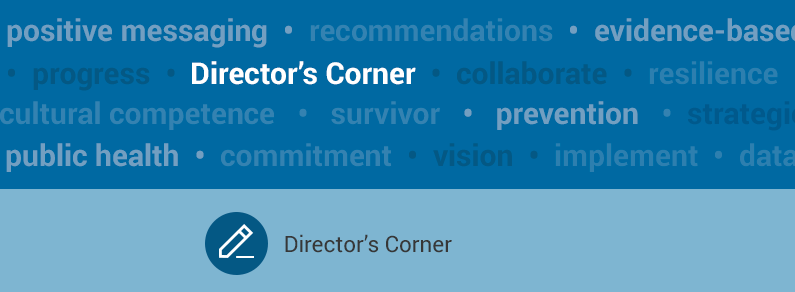Progress and Promise
April 07, 2015

The suicide rate in the United States has remained fairly constant since the end of World War II. This has led some to ask the question, “What more should we be doing?” I would argue that we are making progress and should strengthen current efforts by capitalizing on this progress in ways that I believe will ultimately have an impact on the national suicide rate. It is time to make a greater investment in suicide prevention research and practice.
Twenty years ago, suicide was seen as a private matter – something to be discussed only between a patient and a mental health professional. We did not know much about effectively treating suicide and suicidal behaviors. There was relatively little infrastructure in place to deliver suicide prevention programs. Capacity at the state and national levels was virtually non-existent. We did not discuss suicide or strive collectively to reduce the burden of suicide in our nation.
Many of these conditions have changed and we have seen evidence of progress. Suicide prevention is now discussed earnestly and authentically in public forums. We have learned a great deal about preventing suicide. The SPRC Best Practices Registry includes more than 150 programs, protocols, and practices. More than 30,000 physicians have been trained with SPRC’s Assessing and Managing Suicide Risk program. The National Suicide Prevention Lifeline seamlessly links 165 crisis centers and also provides a dedicated service for veterans. All states – and many tribes and campuses – have received Garrett Lee Smith Memorial grants to fund their suicide prevention efforts. Every state has a suicide prevention plan. And a National Strategy for Suicide Prevention has been written, implemented, and revised. Many non-profit organizations now make a tremendous contribution to strengthening the capacity of our national prevention infrastructure.
Still, the number of people who die by suicide each year remains a national challenge that warrants our collective response. In my view, the key to decreasing the suicide rate is to invest in the widespread adoption of successful prevention strategies and to strengthen our investment in new discoveries. We know enough to understand what works in suicide prevention. Our challenge is to disseminate and implement what works. By widely adopting successes that have been achieved locally or in specific settings, we will see a reduction in the national suicide rate.
Here are four promising strategies we need to take to scale in order to achieve our goal of reducing the burden of suicide and suicidal behaviors nationwide. By no means are these the only strategies we should promote but they are good examples of what is possible.
The first strategy is systems transformation. This is exemplified by the Air Force Suicide Prevention Program which used a comprehensive approach to successfully reduce suicide as well as domestic violence, homicide, and accidental death. Systems transformation is also exemplified by the Zero Suicide approach that has proven so successful in the Henry Ford Health System’s Perfect Depression program, and in other boundaried health care systems.
The second strategy is improving the delivery of crisis services. To build on the success of the National Suicide Prevention Lifeline and the Veterans Crisis Line, we need to expand crisis and support services in local communities. We must improve the capacity of emergency departments and primary care providers to effectively respond to suicidal crises. And we must support greater continuity of care between crisis, treatment, and aftercare and support services.
The third strategy is reducing access to lethal means. Time and time again, restricting access to lethal means has been shown to be an effective method of preventing suicide. Restricting the availability of pesticides reduced the suicide rate in Sri Lanka by 50 percent over ten years. Substituting natural gas for coal gas in home use decreased the suicide rate in the United Kingdom by 30 percent over 13 years. And barring members of the Defense Forces from bringing their weapons home on weekends brought suicides in Israel down by 40 percent in only two years.
The fourth strategy is changing how we talk about suicide. In the words of the National Strategy for Suicide Prevention, we need to “leverage the media and national leaders to change the national narratives around suicide and suicide prevention to ones that promote hope, connectedness, social support, resilience, treatment, and recovery.” Efforts to promote such a change are beginning to show an impact both on media reporting and in the entertainment industry. We are also seeing a shift in public messaging by people in suicide prevention and mental health. I am confident this will contribute to a decrease in the suicide rate.
We are making progress in preventing suicide. We have knowledge of what works and we have an infrastructure to implement effective programs and interventions. We have a prioritized research agenda, so we know where the potential for more progress exists. But to achieve this progress, we must invest in the success we’ve had, bringing it to scale by applying these promising strategies in many more settings and reaching far more of those who will benefit. As Mike Hogan noted in last month’s Director’s Corner on the role of data, we also need to track and measure both the implementation and the outcomes of these strategies.
Although there are other approaches that show promise, these four strategies demonstrate how far we’ve come in our ability to prevent suicide. Our challenge is to implement fully what we know. It will require an investment to bring these successful strategies to more settings where wide-scale adoption will demonstrate reductions in suicide and suicidal behavior. I am confident that this investment will have an impact: a long-overdue decline in our nation’s suicide rate.
“Knowing is not enough; we must apply.
Willing is not enough; we must do.”
-Goethe
